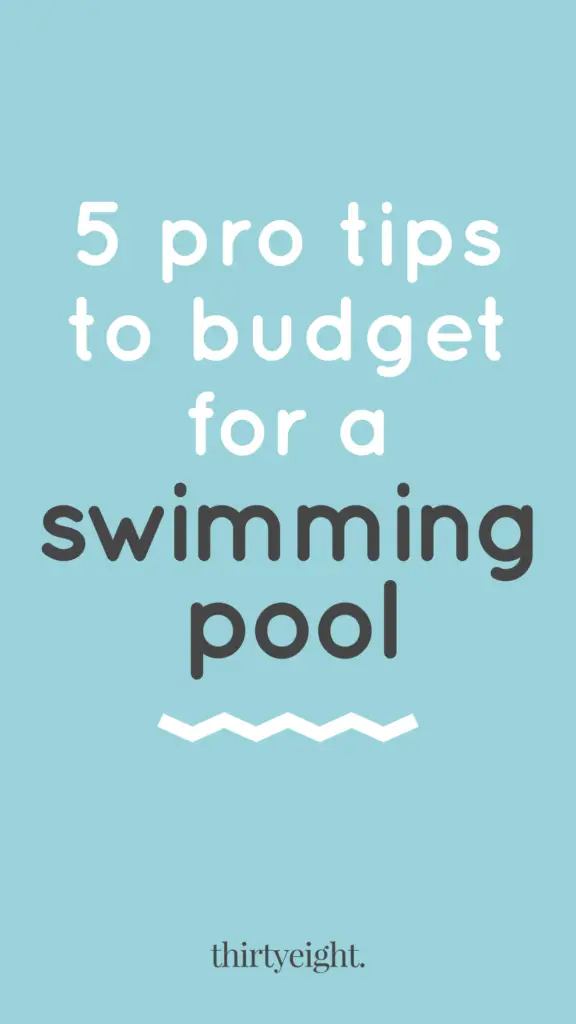Disclosure: This post may contain affiliate links that earn me a small commission, at no additional cost to you! See our disclaimer for details.
What is a Swimming Pool Sinking Fund?
If you are planning on building or owning a swimming pool, it is important to do your math regarding how expensive owning one can be!
Building a backyard pool can cost anywhere from $45,000 to over $100,000. Every year you can expect around an additional $1,000 in cleaning, maintenance, chemical and electrical costs.
If you plan on owning a swimming pool, whether it be a large, above-ground one, or a built-in underground pool, you must first realize that they aren’t very cheap.
Since you’re looking to create a sinking fund, which is a fund for expected expenses, let’s review some of the costs you may have to consider.

12 Expenses to Expect with Owning a Swimming Pool:
- Design and contractor fees
- Delivery and installation
- Fencing
- Landscaping
- Lighting
- Chemicals
- Patio/Deck
- Floatys and other pool accessories
- Retiling, new pool shell, new pool liner
- Yearly cleaning service
- Maintenance and repair services
- Electricity usage
Remember, these should be written down as expected expenses. If you’re planning on owning a swimming pool, it is important to know ahead of time how much it will cost you per year. Otherwise, these costs could quickly become a significant burden to your finances.
Therefore, a sinking fund allows you to set aside these expenses for your future pool! If you know how much you’ll need each year, a sinking fund is perfect to set aside cash and pay for these expected purchases associated with owning a pool.
Be sure to check out my ultimate guide on sinking funds, which details the different types of sinking funds, and my tips for having a successful sinking fund!
As a quick review, if you are new to the concept of sinking funds, a “sinking fund” is money you specifically set aside for expected expenses.
Some people have numerous sinking funds, ones for yearly insurance costs, pets, pool maintenance, Christmas, taxes and so forth. It’s an awesome way for people to not go over budget – and to stay in control of their finances!
Why You Need a Sinking Fund for a Swimming Pool
Considering it can cost over $1,000 every year to maintain your swimming pool, having a sinking fund is extremely helpful to not go over budget, and to prevent going into credit card debt when you weren’t prepared for it!
When putting together your personal list of expenses relating to your pool, remember to account for accidentals! This can include damages and repairs and chemicals for unexpected events.
As mentioned above, sinking funds are helpful to plan for expected expenses, and it is important to plan for such a large yearly expense that you’ll have to pay every year.
5 Quick Tips to Creating a Sinking Fund:
By creating a sinking fund, you can decrease financial stress and strategically plan your spending over the year or over a handful of months.
Use these 5 tips to create a successful sinking fund for your swimming pool:
- Set aside money every paycheck for your swimming pool’s sinking fund. This budgeting habit helps you be prepared for any expense that comes up within the year.
- Don’t lie to yourself about money. It is important to be true to yourself about how much money you plan to spend, or had spent in years past.
- Use a visual tracker. It is very helpful to use cash envelopes, a printable tracker, or an excel spreadsheet to watch for growth of your new sinking fund.
- Use cash for your sinking fund. Setting aside actual cash is a great way for anyone new at budgeting, because it can help you quickly build better financial spending habits.
- Enjoy the process of saving for your sinking fund. Having a sinking fund for your pool can be a fun experience! Encourage your kids to participate in saving money, too!

Use A Printable for your Swimming Pool Sinking Fund
Using a visual tracker for your sinking funds is a great way to ensure consistent saving of your money to build up your sinking fund! It is also fun to watch your sinking fund fill up and grow over time. Plus, utilizing coloring sheets is a common way to track how much you’ve saved for your new sinking fund.
Be sure to download your free coloring sheet for your new sinking fund, above! This printable is a great way to prevent financial stress over the year!
Time needed: 30 minutes.
Use these following steps to make the most of your pool’s sinking fund printable:
- Print out your free printable
Add this sheet to your budgeting binder
- Write down your sinking fund goal
Write how much it will cost over 1 year for owning and maintaining your swimming pool and place this at the top of your sheet
- Divide your sinking fund goal
Write smaller numbers to the outside of the lines
- Determine how much you need to save each paycheck
Do this to achieve your yearly sinking fund goal that yous set
- Every time you contribute to your sinking fund, color in lines on your printable until the next line’s goal
- Complete your yearly sinking fund goal for your pool’s expenses!
4 Tips to Earn More Money for Your Swimming Pool Sinking Fund
If you plan on paying for a pool, big or small, you’ll need to set aside money to fund it.
These 4 steps are good starting points to fund your swimming pool’s sinking fund:
1. Discover how to earn extra cash
2. Watch your net worth and saving accounts
3. Be aware of your financial picture
4. Track your spending
#1. Discover How to Earn Extra Cash
I discovered survey sites awhile back and have been able to make a handful of extra cash to save up for expenses.
Now, this definitely won’t pay for all your pool’s bills and expenses, but being able to pay for an electric bill or pool accessories by simply filling out surveys is pretty awesome!
I know of people who use dozens of survey sites, but I only stick to two. (Honestly, I just don’t have a ton of free time!)
I have a step-by-step article here about how to start with one of my favorite sites!
If you want to double your earnings, check out both of my two favorite apps:
Some extra dollars will always be helpful to fill up your yearly sinking fund!
#2. Watch Your Net Worth and Savings Accounts
I use one app to determine my net worth (a combination of assets and liabilities) and another to set aside money for a savings fund.
To start, I highly recommend you start watching your income and expenses, especially since swimming pools can get pricy. I use a popular, free app called Personal Capital to track all my cash flow. Go check out my in-depth review of this app here to learn how it compares with other money tracking apps!
Secondly, I use an app called Acorns to set aside money for a savings fund.
Acorns works by linking to your bank and helping set aside “cents” to a savings account after you make purchases.
It’s a really neat way to save up money without even thinking about it – and you could literally save up hundreds in a year!
If you’re interested in checking Acorns out, go get your free $5 credited to your account here!
#3. Know your Credit Score Well
Understanding your credit score is a critical part of understanding your personal finances!
My best piece of advice is to know your credit score before making any big purchases – and if you read anything above, then you know swimming pools are fairly expensive.
I use Credit Karma, which I’ve loved for years! Not only is it free, but checking your credit score through them won’t make any difference on your score (unlike some other services out there!).
#4. Track Your Spending!
The whole point of using a sinking fund tracker is to be able to visually track your saving (and spending)!
Many people use free apps like the one I mentioned above, or go old-school and use pen and paper to keep track of their spending.
To learn more about how to get a better hold of your finances, be sure to check out these popular articles!

